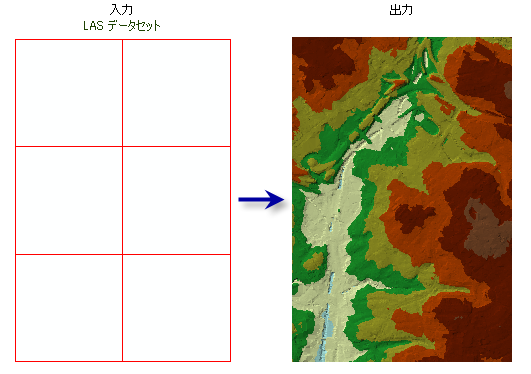サマリー
LAS データセットから TIN をエクスポートします。
図

使用法
-
LAS データセットを入力として指定すると、それが参照する LAS ファイルのすべてのデータ ポイントが処理されます。LAS データセット レイヤーを介して目的の LAS ポイント フィルターを適用することで、分類コード、分類フラグ、およびリターン値で LIDAR データのサブセットを選択することもできます。フィルターは、レイヤー プロパティのダイアログまたは [LAS データセット レイヤーの作成 (Make LAS Dataset Layer)] ツールを使用して定義できます。
-
LAS データセット レイヤーは、LAS データセットから参照される場合のあるサーフェス制御フィーチャの適用の制御にも使用できます。
出力 TIN の生成において、LAS ポイントの間引きをより予測可能な方法で制御する必要がある場合は、[ウィンドウ サイズ] 間引きタイプ (Python では thinning_type = "WINDOW_SIZE") の使用を検討してください。
構文
LasDatasetToTin_3d (in_las_dataset, out_tin, {thinning_type}, {thinning_method}, {thinning_value}, {max_nodes}, {z_factor})| パラメーター | 説明 | データ タイプ |
in_las_dataset | 処理対象の LAS データセット。 | LAS Dataset Layer |
out_tin | 生成される TIN データセット。 | TIN |
thinning_type (オプション) | TIN にエクスポートされる LAS データ ポイントのサブセットの選択に使用する方法を指定します。
| String |
thinning_method (オプション) | LAS データ ポイントを減らすのに使用する方法を指定し、[間引き値] の解釈に影響を与えます。利用できるオプションは、選択される [間引きタイプ] によって異なります。
LAS データ ポイントを減らすのに使用する方法を指定し、thinning_value の解釈に影響を与えます。利用できるオプションは、選択される thinning_type によって異なります。
| String |
thinning_value (オプション) | thinning_type = "WINDOW_SIZE" の場合、この値は LAS データセットを分割するサンプリング領域を表します。 thinning_type = "RANDOM" で thinning_method = "PERCENT" の場合、この値は TIN にエクスポートされる LAS データセットのポイントの割合を表します。 thinning_type = "RANDOM" で thinning_method = "NODE_COUNT" の場合、この値は TIN にエクスポートできる LAS ポイントの総数を表します。 | Double |
max_nodes (オプション) | 出力 TIN で許可するノードの最大数。デフォルトは 500 万です。 | Double |
z_factor (オプション) | Z 値に乗算する係数。これは通常、Z リニア単位から XY リニア単位に変換する場合に使用されます。デフォルトは 1 です。この場合、標高値は変更されません。 | Double |
コードのサンプル
LASDatasetToTin (LAS データセット → TIN) の例 1 (Python ウィンドウ)
次のサンプルは、Python ウィンドウでこのツールを使用する方法を示しています。
import arcpy
from arcpy import env
arcpy.CheckOutExtension('3D')
env.workspace = 'C:/data'
arcpy.LasDatasetToTin_3d('se_baltimore.lasd', 'se_bmore', 'RANDOM', 15, 3.28)
LASDatasetToTin (LAS データセット → TIN) の例 2 (スタンドアロン スクリプト)
次のサンプルは、スタンドアロン Python スクリプトでこのツールを使用する方法を示しています。
'''**********************************************************************
Name: LAS Dataset to TIN Example
Description: Create a TIN using bare earth lidar measurements. This
script is designed for use as a script tool.
**********************************************************************'''
# Import system modules
import arcpy
import exceptions, sys, traceback
# Set Local Variables
lasD = arcpy.GetParameterAsText(0)
inLas = arcpy.GetParameterAsText(1) #input las files
surfCons = arcpy.GetParameterAsText(2) #input surface constraints
sr = arcpy.GetParameter(3) #spatial reference of las dataset
outTin = arcpy.GetParameterAsText(4)
thinningType = arcpy.GetParameterAsText(5)
thinningMethod = arcpy.GetParameterAsText(6)
thinningValue = arcpy.GetParameter(7)
zFactor = arcpy.GetParameter(8)
try:
arcpy.CheckOutExtension('3D')
# Execute CreateLasDataset
arcpy.management.CreateLasDataset(inLas, lasD, 'RECURSION', surfCons, sr)
lasLyr = arcpy.CreateUniqueName('lasdToTin', 'in_memory')
classCode = 2
returnValue = 'LAST'
# Execute MakeLasDatasetLayer
arcpy.management.MakeLasDatasetLayer(lasD, lasLyr, classCode, returnValue)
# Define extent of the area of interest
env.extent(1426057, 606477, 1449836, 623246)
# Execute LasDatasetToTin
arcpy.ddd.LasDatasetToTin(lasLyr, outTin, thinningType,
thinningMethod, thinningValue, zFactor)
arcpy.CheckInExtension('3D')
except arcpy.ExecuteError:
print arcpy.GetMessages()
except:
# Get the traceback object
tb = sys.exc_info()[2]
tbinfo = traceback.format_tb(tb)[0]
# Concatenate error information into message string
pymsg = 'PYTHON ERRORS:\nTraceback info:\n{0}\nError Info:\n{1}'\
.format(tbinfo, str(sys.exc_info()[1]))
msgs = 'ArcPy ERRORS:\n {0}\n'.format(arcpy.GetMessages(2))
# Return python error messages for script tool or Python Window
arcpy.AddError(pymsg)
arcpy.AddError(msgs)
環境
ライセンス情報
- ArcGIS Desktop Basic: 次のものが必要 3D Analyst
- ArcGIS Desktop Standard: 次のものが必要 3D Analyst
- ArcGIS Desktop Advanced: 次のものが必要 3D Analyst